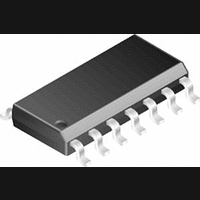LMC6034IM National Semiconductor, LMC6034IM Datasheet - Page 7

LMC6034IM
Manufacturer Part Number
LMC6034IM
Description
Operational Amplifier (Op-Amp) IC
Manufacturer
National Semiconductor
Specifications of LMC6034IM
No. Of Amplifiers
4
Slew Rate
1.1V/µs
No. Of Pins
14
Peak Reflow Compatible (260 C)
No
Leaded Process Compatible
No
Mounting Type
Surface Mount
Package / Case
14-NSOIC
Lead Free Status / RoHS Status
Contains lead / RoHS non-compliant
Available stocks
Company
Part Number
Manufacturer
Quantity
Price
Company:
Part Number:
LMC6034IM
Manufacturer:
NS
Quantity:
10 990
Part Number:
LMC6034IM
Manufacturer:
NS/国半
Quantity:
20 000
Part Number:
LMC6034IM-TEL
Manufacturer:
NS/国半
Quantity:
20 000
Part Number:
LMC6034IMX
Manufacturer:
NS/国半
Quantity:
20 000
Company:
Part Number:
LMC6034IMX/NOPB
Manufacturer:
ST
Quantity:
7 733
Part Number:
LMC6034IMX/NOPB
Manufacturer:
TI/德州仪器
Quantity:
20 000
Applications Hint
pacitance, or to tolerate additional phase shifts in the loop, or
excessive capacitive load, or to decrease the noise or band-
width, or simply because the particular circuit implementa-
tion needs more feedback capacitance to be sufficiently
stable. For example, a printed circuit board’s stray capaci-
tance may be larger or smaller than the breadboard’s, so the
actual optimum value for C
estimated using the breadboard. In most cases, the values
of C
the computed value.
Capacitive Load Tolerance
Like many other op amps, the LMC6034 may oscillate when
its applied load appears capacitive. The threshold of oscilla-
tion varies both with load and circuit gain. The configuration
most sensitive to oscillation is a unity-gain follower. See
Typical Performance Characteristics.
The load capacitance interacts with the op amp’s output re-
sistance to create an additional pole. If this pole frequency is
sufficiently low, it will degrade the op amp’s phase margin so
that the amplifier is no longer stable at low gains. As shown
in Figure 3 , the addition of a small resistor (50
series with the op amp’s output, and a capacitor (5 pF to 10
pF) from inverting input to output pins, returns the phase
margin
lower-frequency circuit operation. Thus larger values of ca-
pacitance can be tolerated without oscillation. Note that in all
cases, the output will ring heavily when the load capacitance
is near the threshold for oscillation.
Capacitive load driving capability is enhanced by using a pull
up resistor to V
ducting 500 µA or more will significantly improve capacitive
load responses. The value of the pull up resistor must be de-
termined based on the current sinking capability of the ampli-
fier with respect to the desired output swing. Open loop gain
of the amplifier can also be affected by the pull up resistor
(see Electrical Characteristics).
FIGURE 3. Rx, Cx Improve Capacitive Load Tolerance
FIGURE 4. Compensating for Large Capacitive Loads
F
should be checked on the actual circuit, starting with
to
a
+
( Figure 4 ). Typically a pull up resistor con-
with a Pull Up Resistor
safe
value
F
may be different from the one
(Continued)
without
DS011134-22
interfering
DS011134-5
to 100 ) in
with
7
PRINTED-CIRCUIT-BOARD LAYOUT
FOR HIGH-IMPEDANCE WORK
It is generally recognized that any circuit which must operate
with less than 1000 pA of leakage current requires special
layout of the PC board. When one wishes to take advantage
of the ultra-low bias current of the LMC6034, typically less
than 0.04 pA, it is essential to have an excellent layout. For-
tunately, the techniques for obtaining low leakages are quite
simple. First, the user must not ignore the surface leakage of
the PC board, even though it may sometimes appear accept-
ably low, because under conditions of high humidity or dust
or contamination, the surface leakage will be appreciable.
To minimize the effect of any surface leakage, lay out a ring
of foil completely surrounding the LMC6034’s inputs and the
terminals of capacitors, diodes, conductors, resistors, relay
terminals, etc. connected to the op-amp’s inputs. See Figure
5 . To have a significant effect, guard rings should be placed
on both the top and bottom of the PC board. This PC foil
must then be connected to a voltage which is at the same
voltage as the amplifier inputs, since no leakage current can
flow between two points at the same potential. For example,
a PC board trace-to-pad resistance of 10
mally considered a very large resistance, could leak 5 pA if
the trace were a 5V bus adjacent to the pad of an input. This
would cause a 100 times degradation from the LMC6034’s
actual performance. However, if a guard ring is held within
5 mV of the inputs, then even a resistance of 10
cause only 0.05 pA of leakage current, or perhaps a minor
(2:1) degradation of the amplifier’s performance. See Fig-
ures 6, 7, 8 for typical connections of guard rings for stan-
dard op-amp configurations. If both inputs are active and at
high impedance, the guard can be tied to ground and still
provide some protection; see Figure 9 .
FIGURE 5. Example of Guard Ring in P.C. Board
Layout
12
, which is nor-
www.national.com
11
DS011134-6
would











